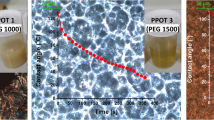Abstract
Polyurethane cationomers with increased contents of ions were synthesised in the reaction of 4,4′-methylenebis(phenyl isocyanate) (MDI) with polyoxypropylene glycol (M = 450) and N-methyl diethanolamine (N-MDA). Amine segments were built-in to the urethane–isocyanate prepolymer in the reaction with formic acid and then they were converted to alkyl-ammonium cations. The obtained isocyanate prepolymers were then extended in the aqueous medium with the use of 1,6-hexamethylenediamine. That yielded stable aqueous dispersions, which were applied on the surfaces of test poly(tetrafluoroethylene) samples. After evaporation of water, the dispersions formed thin polymer coatings. 1H and 13C NMR spectral methods were employed to confirm chemical structures of synthesised cationomers and to modify their quantitative composition in relation to that assumed on the basis of the stoichiometry of the reactions, which were conducted on successive stages of the polyaddition process. Furthermore, the GPC method was used to learn the sizes and distributions of mean molecular weights of those cationomers. Based on 1H NMR spectra, the factor κ was calculated which represented the polarity level of the obtained cationomers. Good correlation was found between that factor and the free surface energy γ S (increasing in the range 38–42 mJ/m2) as well as its polar and acid-base components, as determined from the van Oss–Good model on the basis of measured wetting angles between the coatings and model liquids with various polarities. The values of κ and γ S parameters resulted principally from the increasing amounts of cations NH+, which were evaluated on the basis of the concentrations of tertiary nitrogen atoms increasing within 1.37–2.66 wt%. Those concentrations and amounts resulted, in turn, from the amounts of amine N-MDA which could be built into cationomers. The effects were discussed of chemical structures and polarity specifications of polyurethane cationomers on the viscosities of produced aqueous dispersions and on the sizes of their colloidal particles, on the values of free surface energy and on its polar and acid-base components, and on the glass transition temperatures T g2 of the rigid segments as found by the differential scanning calorimetry (DSC) method.







Similar content being viewed by others
References
Santerrre JP, Brash JL (1997) Ind Eng Chem Res 36:1352
Lee SJ, Kim Kyu B (1993) J Korean Fiber Soc 30:766
Sato H, Hagio K (2002) Method for resource recovery of fragmental wood for new house and/or woody waste materials of demolished. Patent No. JP2002262690
Buruiana EC, Buruiana T, Strat G, Strat M (2005) J Polym Sci Part A Polym Chem 43:3945
Sundar S, Arua P, Venkateshwarlu U, Radhakrishnan G (2004) Colloid Polym Sci 283:209
Good JR (1991) In: Lee LH (ed) Fundamentals of adhesion. New York, Dekker, p 153
Żenkiewicz M (2006) Polimery 51:169
Król P, Król B, Holler P, Pikus S, Kozak M (2006) Colloid Polym Sci 285:169
Author information
Authors and Affiliations
Corresponding author
Rights and permissions
About this article
Cite this article
Król, P., Król, B. Polyurethane cationomers synthesised with 4,4′-methylenebis(phenyl isocyanate), polyoxyethylene glycol and N-methyl diethanolamine. Colloid Polym Sci 286, 1111–1122 (2008). https://doi.org/10.1007/s00396-008-1870-6
Received:
Revised:
Accepted:
Published:
Issue Date:
DOI: https://doi.org/10.1007/s00396-008-1870-6



